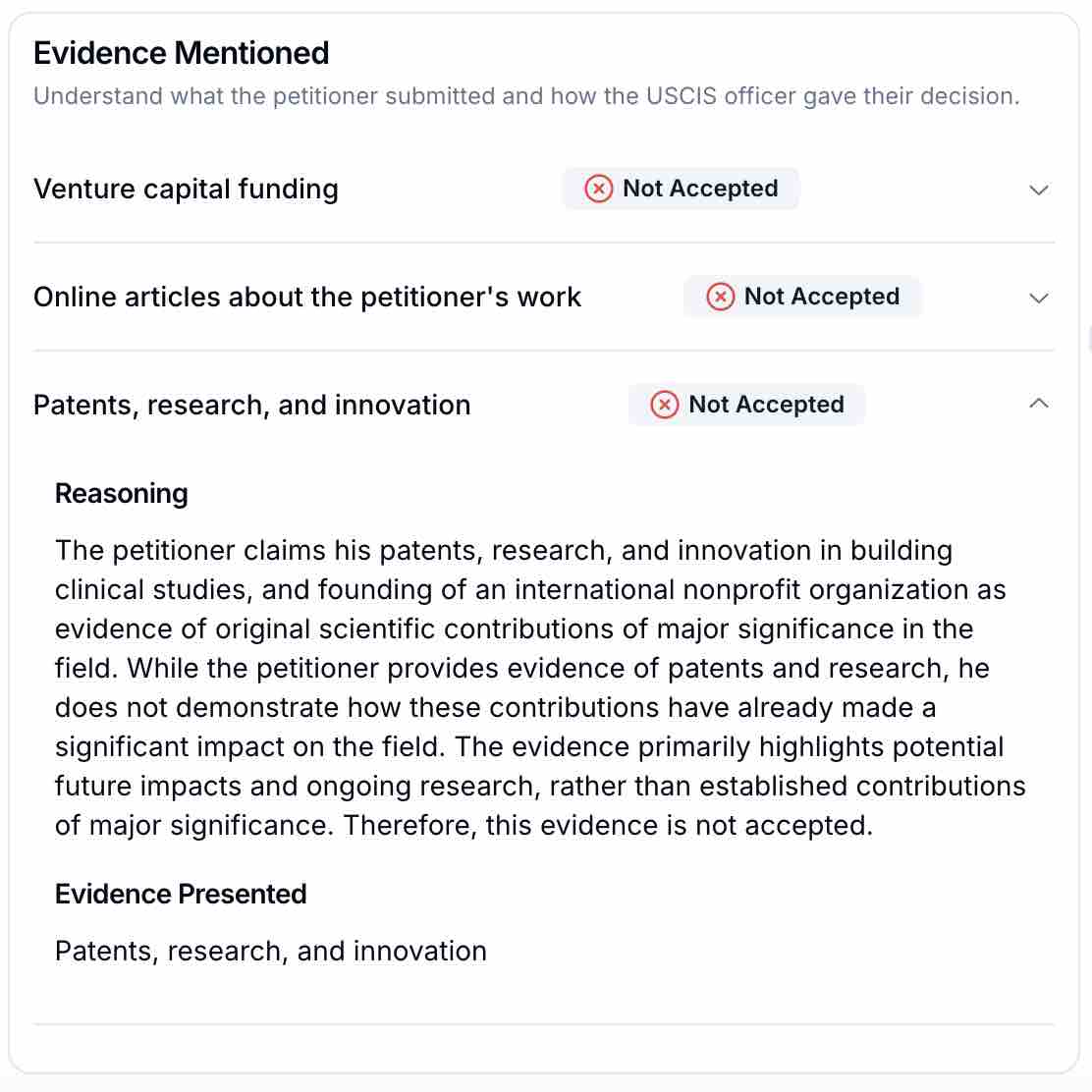When it comes to the EB-1A visa category, many applicants often believe that securing patents for their work is a critical step toward proving their extraordinary ability. However, this widespread belief is based on a common misunderstanding of what the U.S. Citizenship and Immigration Services (USCIS) truly values when assessing an EB-1A petition.
At Immibadger, we sift through thousands of appeal documents, including AAO non-precedent decisions, to help skilled professionals understand the intricate details of how their applications will be evaluated. Through our research, we’ve discovered that patents, while potentially helpful, are far from the be-all and end-all of an EB-1A application.
Debunking the Patent Myth: What USCIS Really Looks For
It’s a common misconception that having a patent automatically strengthens your EB-1A case, or conversely, that not having a patent might weaken it. Both of these beliefs are, in fact, misguided.
The patent system is designed to recognize the novelty of an invention, confirming that the technology or idea has not been seen before. While this is important for intellectual property protection, novelty alone does not meet the bar set by USCIS for proving extraordinary ability.
For USCIS, it’s not enough to demonstrate that your technology is new—you need to show that it has impact. This impact must be measurable, visible, and significant in your field. Without proving impact, even the most groundbreaking patent won’t help your case.
Patents vs. Impact: Which Matters More?
Let’s compare two hypothetical petitioners:
- Petitioner A holds multiple patents for their inventions, but their work has yet to make a notable impact in their field. Despite the novelty, their patented technology hasn’t been adopted by other professionals, and there’s little evidence of its economic or societal influence.
- Petitioner B, on the other hand, has designed an impactful technology that is widely recognized and used in their industry, but it remains unpatented. Their work has been cited in numerous publications, and they’ve received government funding to further their research due to its significant influence.
If you were USCIS, who would you choose as the stronger candidate for an EB-1A visa? Without a doubt, Petitioner B would have a far stronger case because they can prove the real-world impact of their work.
This example illustrates the crux of the issue: USCIS cares about impact, not just novelty. While patents can demonstrate originality, they don’t necessarily prove that your work has made a significant contribution to your field. It’s the tangible effects of your work—the influence it has had on others, its economic or social benefits, and its widespread adoption—that truly matter.
Patents and the EB-1A: Answering Common Questions
So, let’s address two key questions that often come up:
- Do I need to have patents to apply for EB-1A?
- No, you do not need a patent to apply for an EB-1A visa. The key criterion is not whether you have a patent, but whether your work demonstrates extraordinary ability and has made a significant impact in your field.
- If I have patents, does it mean I automatically qualify for EB-1A?
- Again, the answer is no. A patent alone is not enough to prove that your work qualifies as a contribution of major significance. The USCIS requires evidence of how your work, patented or not, has had a broad and measurable influence in your field.
How to Demonstrate Impact
For those wondering how to showcase the significance of their work, whether patented or not, consider these four critical factors:
- Has your work impacted subsequent research or innovations?
- Show how your contributions have influenced others in your field. Are your findings cited in key research papers? Have other professionals built upon your work?
- Is there widespread discussion or recognition of your contribution?
- Media coverage, industry recognition, or mentions in key publications can help demonstrate that your work is known and respected within your professional community.
- What is the documented economic, social, technological, or scientific impact of your work?
- USCIS wants to see tangible results. Has your work led to the development of new products, created jobs, or advanced technology in a way that benefits society?
- Is there government or industry interest in your contribution?
- Securing government funding, industry partnerships, or other formal recognitions can serve as strong evidence of your work’s significance.
What AAO Appeal Decisions Reveal About Patents

Our analysis of Administrative Appeals Office (AAO) non-precedent decisions further reinforces this perspective. In one such decision (JUL212020_02B2203), the petitioner was optimistic about the potential of their patented technology, but the AAO ruled that potential future impact was not enough. The AAO emphasized that "a patent generally recognizes the originality of an invention or idea but does not necessarily establish a contribution of major significance in the field." The petitioner failed to demonstrate how their work had already made a significant contribution, thus highlighting the importance of actual impact over mere novelty.
Conclusion: Focus on Impact, Not Patents
The takeaway is clear: while patents can be useful in demonstrating originality, they are not a guarantee of success in an EB-1A petition. If you are aiming for this visa, your focus should be on proving the measurable impact of your work, whether or not it is patented. USCIS cares far more about how your contributions have influenced your field than whether or not your technology is novel.
At Immibadger, we help skilled immigrants navigate the complexities of the EB-1A visa process by providing insights into AAO appeal decisions, so you can better understand what USCIS is truly looking for. If you’re working on your petition, remember: it’s not about the patent—it’s about the impact.
